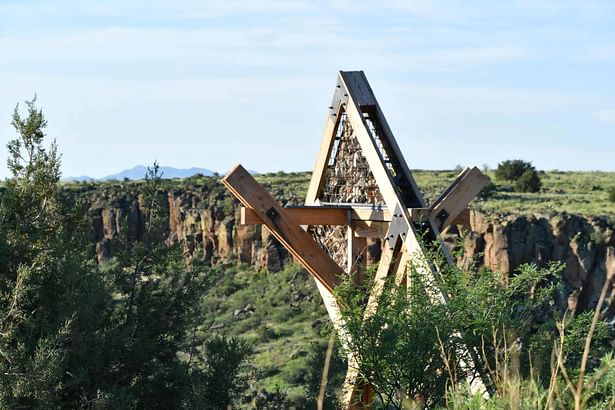
Mayer, AZ

Since its departure from Taliesin West—Frank Lloyd Wright’s former home outside of Phoenix, Arizona—The School of Architecture (TSOA), has set up camp in Arcosanti, an alternative community north of Phoenix, and has continued its annual showcase of signature graduate thesis projects. At TSOA students are given the opportunity to design and construct a shelter instead of completing a traditional senior thesis. Once constructed, these shelters are utilized as student housing or public space for the community. The School of Architecture’s Shelter Program has been part of the school’s curriculum since its creation in the 1930s and is deeply rooted in the pedagogy of its founder, Wright, who emphasized hands-on learning and immersion as an alternative to traditional architecture education.
Each shelter project is accompanied by a written thesis, which elucidates the conceptual and theoretical elements which motivated the construction of the shelter. Historically, the shelters were designed to harmonize with the landscape of the Sonoran Desert which surrounds Taliesin West. Since TSOA’s relocation in 2020, many students have collaborated with local organizations in Arcosanti to build their shelters, incorporating the town’s unique and imaginative approach to architecture and sustainability into their designs.
The town of Arcosanti hosted student workshops and construction projects long before TSOA relocated to the area. Arcosanti, built in 1970, was founded by Paolo Soleri, an Italian architect who had studied under Wright at Taliesin West in the 1940s. Soleri coined the term archology—a portmanteau of architecture and ecology—to describe his interest in sustainable urban development. Soleri mass-produced wind bells made of bronze and clay in order to fund construction at Arcosanti, a practice that the community continues today despite Soleri’s passing in 2013. Although only between 50 and 100 people live permanently in Arcosanti, the community receives 40,000 visitors a year and hosts a number of craft related workshops which provide the labor for the community’s construction projects.
In 2022 three new shelters were completed by graduating students. Octahedron, a shelter designed and constructed by student Archie Kinney, stands upon a hilltop, providing an impressive view of the desert landscape surrounding Arcosanti. Constructed out of timber and stone caged in wire mesh, Octahedron’s radical geometry distinguishes it from the low brush of the sparse desert landscape which surrounds it. In addition to its stunning view, Octahedron reflects upon the history of Arcosanti, featuring artifacts from the town’s past which are refigured within the context of this new structure.
Earth Shed, designed and constructed by student Richard Sanchez, sources local materials and labor from Arcosanti, including the clay on its exterior, which Sanchez harvested from the Agua Fria river in nearby Phoenix and the construction assistance which Sanchez received from Arcosanti’s agricultural department. Earth Shed consists of a one room structure topped by a gable roof. The shelter’s simple design affords it a variety of uses and makes it an easily reproducible model for sustainable building using local materials and labor.
Vergence, designed and constructed by student William Palmer, confronts the logistical constraints of professional architectural practice. Using donated materials and local workforce, Palmer’s shelter demonstrates how design can be prioritized despite a limited budget. Palmer’s shelter is covered by a complex jute-rope net which shades the structure’s wood base. Vergence demonstrates one of the pedagogical aims of the shelter thesis, which is to confront students with the real world limitations posed by the logistics of construction and budget.
Written by Trevor Schillaci, The Architect's Newspaper. September 27, 2022
No Comments
Block this user
Are you sure you want to block this user and hide all related comments throughout the site?
Archinect
This is your first comment on Archinect. Your comment will be visible once approved.